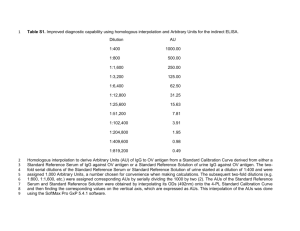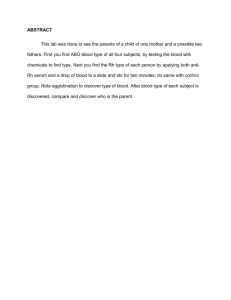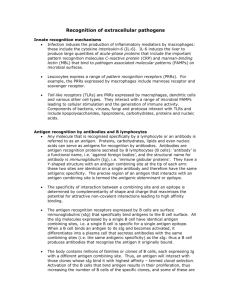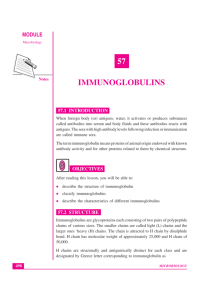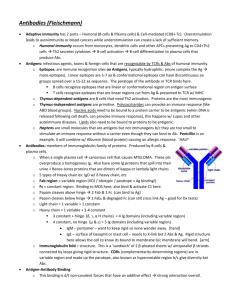5-6-7-8
advertisement
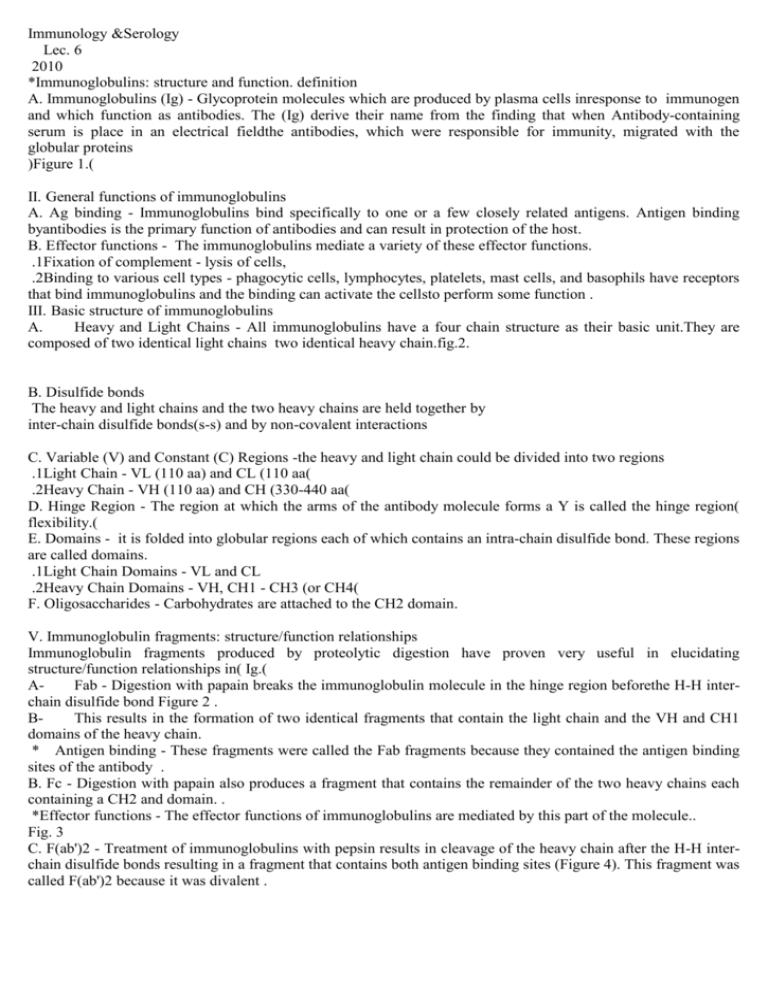
Immunology &Serology Lec. 6 2010 *Immunoglobulins: structure and function. definition A. Immunoglobulins (Ig) - Glycoprotein molecules which are produced by plasma cells inresponse to immunogen and which function as antibodies. The (Ig) derive their name from the finding that when Antibody-containing serum is place in an electrical fieldthe antibodies, which were responsible for immunity, migrated with the globular proteins (Figure 1.) II. General functions of immunoglobulins A. Ag binding - Immunoglobulins bind specifically to one or a few closely related antigens. Antigen binding byantibodies is the primary function of antibodies and can result in protection of the host. B. Effector functions - The immunoglobulins mediate a variety of these effector functions. .1Fixation of complement - lysis of cells, .2Binding to various cell types - phagocytic cells, lymphocytes, platelets, mast cells, and basophils have receptors that bind immunoglobulins and the binding can activate the cellsto perform some function . III. Basic structure of immunoglobulins A. Heavy and Light Chains - All immunoglobulins have a four chain structure as their basic unit.They are composed of two identical light chains two identical heavy chain.fig.2. B. Disulfide bonds The heavy and light chains and the two heavy chains are held together by inter-chain disulfide bonds(s-s) and by non-covalent interactions C. Variable (V) and Constant (C) Regions -the heavy and light chain could be divided into two regions .1Light Chain - VL (110 aa) and CL (110 aa) .2Heavy Chain - VH (110 aa) and CH (330-440 aa) D. Hinge Region - The region at which the arms of the antibody molecule forms a Y is called the hinge region( flexibility.) E. Domains - it is folded into globular regions each of which contains an intra-chain disulfide bond. These regions are called domains. .1Light Chain Domains - VL and CL .2Heavy Chain Domains - VH, CH1 - CH3 (or CH4) F. Oligosaccharides - Carbohydrates are attached to the CH2 domain. V. Immunoglobulin fragments: structure/function relationships Immunoglobulin fragments produced by proteolytic digestion have proven very useful in elucidating structure/function relationships in( Ig.) AFab - Digestion with papain breaks the immunoglobulin molecule in the hinge region beforethe H-H interchain disulfide bond Figure 2 . BThis results in the formation of two identical fragments that contain the light chain and the VH and CH1 domains of the heavy chain. * Antigen binding - These fragments were called the Fab fragments because they contained the antigen binding sites of the antibody . B. Fc - Digestion with papain also produces a fragment that contains the remainder of the two heavy chains each containing a CH2 and domain. . *Effector functions - The effector functions of immunoglobulins are mediated by this part of the molecule.. Fig. 3 C. F(ab')2 - Treatment of immunoglobulins with pepsin results in cleavage of the heavy chain after the H-H interchain disulfide bonds resulting in a fragment that contains both antigen binding sites (Figure 4). This fragment was called F(ab')2 because it was divalent . VII. Structure and some properties of Ig classes and subclasses A IgG -Gamma (?) heavy chains .1Structure - The structures of the IgG subclasses are presented in Figure 5. All IgG's are monomers (7S immunoglobulin). The subclasses differ in the number of disulfide bonds and length of the hinge region. Fig 5 .2Properties. a) IgG is the major Ig in serum - 75% of serum Ig is IgG b) IgG is the major Ig in extra vascular spaces c) Placental transfer - IgG is the only class of Ig that crosses the placenta. ; IgG2 does not cross well. d) Fixes complemente) Binding to cells - Macrophages, monocytes, PMN's and some lymphocytes have Fc eceptors for the Fc region of IgG. . IgG is a good opsonin.. B. IgM- Mu (?) heavy chains .1Structure - The structure of IgM is presented in Figure 6. IgM normally exists as a pentamer (19S immunoglobulin) but it can also exist as a monomer.IgM has an extra domain on the ? chain (CH4) and it has another protein covalently bound via aS-S bond called the J chain. Fig 6. .2Properties a) IgM is the 3rd most common serum Ig. b) IgM is the first Ig to be made by the fetus and the first Ig to be made by a virgin B cells when it is stimulated by antigen. c) its pentameric structure, IgM is a good complement fixing Ig. . d) IgM is also a good agglutinating Ig . Thus, IgM are very good in clumping m.o for elimination from the body. e) IgM binds to some cells via Fc receptors. f) B cell surface Ig - Surface IgM exists as a monomer and lacks J chain but it has an extra 20 amino acids at the C-terminal end to anchor it into the membrane (Figure 7 .) C IgA- Alpha (?) heavy chains .1Structure - Serum IgA is a monomer but IgA found in secretions is a dimer as presented in Figure 7. When IgA exits as a dimer, a J chain is associated with it.When IgA is found in secretions is also has another protein associated with it called the secretory sIgA is sometimes referred to as 11S immunoglobulin . .2Properties a) IgA is the 2nd most common serum Ig. b) IgA is the major class of Ig in secretions - tears, saliva, colostrum, mucus. Since it is found in secretions secretory IgA is important in local (mucosal) immunity. c) Normally IgA does not fix complement, unless aggregated. d) IgA can binding to some cells - PMN's and some lymphocytes. D. IgD - Delta (?) heavy chains .1Structure - The structure of IgD is presented in the Figure 8. IgD exists only as a monomer. .2Properties a) IgD is found in low levels in serum; its role in serum uncertain. b) IgD is primarily found on B cell surfaces where it functions as a receptor for antigen.IgD on the surface of B cells has extra amino acids at C-terminal end for anchoring to the membrane. It also associates with the Ig-? and Ig-â chains. c) IgD does not bind complement. E. IgE- Epsilon (?) heavy chains .1Structure - The structure of IgE is presented in Figure 9. IgE exists as a monomer and has an extra domain in the constant region. Fig. 9 .2Properties a)IgE is the least common serum Ig since it binds very tightly to Fc rceptors on basophils and mast cells even before interacting with antigen. b) Involved in allergic reactions. c) IgE also plays a role in parasitic helminth diseases. Since serum IgE levels rise in parasitic diseases, measuring IgE levels is helpful in diagnosing parasitic infections. Eosinophils have Fc receptors for IgE and binding of eosinophils to IgE-coated helminths results in killing of the parasite. d) IgE does not fix complement. munology & serology Lec -72009-2010 munogen - A substance that induces a specific immune response. Antigen (Ag) - A substance that reacts with the products of a specific immune response. Hapten - A substance that is non-immunogenic but which can react with the products of a specific immune response. Haptens are lecules which could never induce an immune response when administered by themselves but which can when coupled to a carrier mo ptens have the property of antigenicity but not immunogenicity. Epitope or Antigenic Determinant - That portion of an antigen that combines with the products of a specific immune response. Antibody (Ab) - A specific protein which is produced in response to an immunogen and which reacts with an antigen. FACTORS INFLUENCING IMMUNOGENICITY Contribution of the Immunogen Foreignness - The immune system normally discriminates between self and non-self such that only foreign molecules are immunogenic. Size - There is not absolute size above which a substance will be immunogenic. Chemical Composition - In general, the more complex substances ( chemically) the more immunogenic it will be.y structure of the molec Physical form - In general particulate antigens are more immunogenic than soluble ones and denatured antigens more immunogenic th ive form. Degradability - Antigens that are easily phagocytosed are generally more immunogenic. This is because for most antigens (T-dep igens, see below) the development of an immune response requires that the antigen be phagocytosed, processed and presented to he s by an antigen presenting cell (APC). Contribution of the Biological System Genetic Factors - Some substances are immunogenic in one species but not in another. Similarly, some substances are immunogenic ividual but not in others . Age - Method of Administration Dose - The dose of administration of an immunogen can influence its immunogenicity. Route - Generally the subcutaneous route is better than the intravenous or intragastric routes. The route of antigen administration can als nature of the response Adjuvants - Substances that can enhance the immune response to an immunogen are called adjuvants. CHEMICAL NATURE OF IMMUNOGENS Proteins -The vast majority of immunogens are proteins. These may be pure proteins or they may be glycoproteins or lipoproteins. In g teins are usually very good immunogens. Polysaccharides - Pure polysaccharides and lipopolysaccharides are good immunogens. Nucleic Acids - Nucleic acids are usually poorly immunogenic. However, they may become immunogenic when single stranded or mplexed with proteins. Lipids - In general lipids are non-immunogenic, although they may be haptens. TYPES OF ANTIGENS T-independent Antigens - T-independent antigens are antigens which can directly stimulate the B cells to produce antibody witho ument for T cell help such as, polysaccharides. T-dependent Antigens - T-dependent antigens are those that do not directly stimulate the production of antibody without the help of T ce SUPERANTIGENS uperantigens stimulate T cells non-specifically without normal antigenic recognition n. Cytokines are released in large am using the symptoms of ToxicShockSyndrom v(TSS). Superantigens bind directly to class II major histocompatibility comple igen-presenting cells outside the conventional antigen-binding grove. This complex recognizes only the Vb element of the eptor. For example superantigens include: Staphylococcal enterotoxins (food poisoning), gy Lec( 8 ) 2008-2009 Ab & Ag reaction dy reactions The combining site of an antibody is located in the Fab portion of the molecule he bonds that hold the Ag in the antibody combining site are all non-covalent in nature. These include* H-H bonds, *Van der Waals f nity - Ab affinity is the strength of the reaction between a single Ag determinant and a single combining site on the Ab. . the overall strength of binding of an Ag with many antigenic determinants and multivalent antibodies. activity-. Specificity - individual Ab combining site to react with only one antigenic determinant .. Abs can distinguish differences in (1) th ric forms of an Ag, and (3) secondary and tertiary structure of an antigen.. of an individual Ab combining site to react with more than one antigenic determinant . nation - When the Ag is particulate the reaction of an Ab with the Ag can be detected by agglutination (clumping) of the Ag. *When the lutination is used.. est -. For example, a patient's red blood cells can be mixed with Ab to a blood group Ag to determine a person's blood type. . test -. In this test one makes serial dilutions of a sample to be tested for Ab and then adds a fixed number of red blood cells or bacteria o um dilution which gives agglutination. The maximum dilution that gives visible agglutination is called the titer..*Prozone effect - * high (i.e. lower dilutions), there is no agglutination and then as the sample is diluted agglutination on tests pes or antibodies to blood group antigens. ons atin - , it is possible to coat erythrocytes with a soluble antigen (e.g. viral antigen, a polysaccharide or a h ulin Test) hen Abs bind to erythrocytes, they do not always result in agglutination. This can result from the Ag/Ab ratio being in antigen excess o This test is done by incubating the red blood cells with the serum sample, washing out any unbound antibodies and then adding a se ross link the cells. of anti-Rh-Abs. Abs to the Rh factor generally do not agglutinate red blood cells. Thus, red cells from Rh + children born to Rh- mothers, oated with these antibodies. tion - It is called hemagglutination inhibition because one measures the ability of soluble Ag to inhibit the agglutination of Ag-coated red b Mancini) -. As the Ag diffuses into the gel it reacts with the Ab and a ring of precipitation is formed. The diameter of Ab is constant. s - a complex mixture of Ags is placed in a well punched out of an agar gel and the Ags are electrophoresed . so that the Ag are A)/Enzyme Linked Immunosorbent Assay (ELISA) easurement of an enzymatic reaction associated with immune complexes. In any particular assay the enzyme may be linked to either the d Antigens Ab labeled with a fluorescent molecule (fluorescein ) is used to detect the presence of an Ag. e - the Ab specific to the Ag is directly tagged with the fluorochrome . cence -the Ab specific for the Ag is unlabeled and a second anti-immunoglobulin antibody directed toward the first antibody is tagge sed in the clinical laboratory to identify and enumerate cells bearing a particular antigen.. The cells are then analyzed on the flow cytomet

